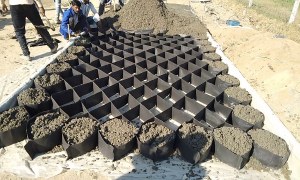🕑 Reading time: 1 minute
The stages of cracking (fracture) in concrete: There are three stages of cracking or fracture in concrete. When we describe the cracking mechanisms, it is important to differentiate between the mode of crack initiation and how this occurs at the microscopic level, and the subsequent paths of propagation and the eventual macroscopic crack pattern at the engineering level. Although some discontinuities exist as a result of the compaction process of fresh concrete, the formation of small fissures or micro-cracks in concrete is due primarily to the strain and stress concentrations resulting from the incompatibility of the elastic moduli of the aggregate and paste components. Following are the Stages of Concrete Cracking: Stage I: Even before loading, intrinsic volume changes in concrete due to shrinkage or thermal movements can cause strain concentrations at the aggregate–paste interface. Within this stage localized cracks are initiated at the microscopic level at isolated points throughout the specimen where the tensile strain concentration is the largest. This shows that these cracks are stable and, at this load stage, do not propagate Stage II: As the applied load is increased beyond Stage I, initially stable cracks begin to propagate. There will not be a clear distinction between Stages I and II since stable crack initiation is likely to overlap crack propagation and there will be gradual transition from one stage to another. This is shown in Fig.1. During Stage II the crack system multiplies and propagates but in a slow stable manner in the sense that, if loading is stopped and the stress level remains constant propagation ceases. The extent of the stable crack propagation stage will depend markedly upon the applied state of stress, being very short for ‘brittle’ fractures under predominantly tensile stress states and longer for more ‘plastic’ fractures under predominantly compressive states of stress.
Stage III: This occurs when, under load, the crack system has developed to such a stage that it becomes unstable and the release of strain energy is sufficient to make the cracks self-propagate until complete disruption and failure occurs. Once Stage III is reached failure will occur whether or not the stress is increased. This stage starts at about 70–90 per cent of ultimate stress and is reflected in an overall expansion of the structure as signified by a reversal in the volume change behaviour. As stated above, the load stage at which this occurs corresponds approximately to the long-term strength of concrete.
The extent of the stable crack propagation stage will depend markedly upon the applied state of stress, being very short for ‘brittle’ fractures under predominantly tensile stress states and longer for more ‘plastic’ fractures under predominantly compressive states of stress.
Stage III: This occurs when, under load, the crack system has developed to such a stage that it becomes unstable and the release of strain energy is sufficient to make the cracks self-propagate until complete disruption and failure occurs. Once Stage III is reached failure will occur whether or not the stress is increased. This stage starts at about 70–90 per cent of ultimate stress and is reflected in an overall expansion of the structure as signified by a reversal in the volume change behaviour. As stated above, the load stage at which this occurs corresponds approximately to the long-term strength of concrete. 

